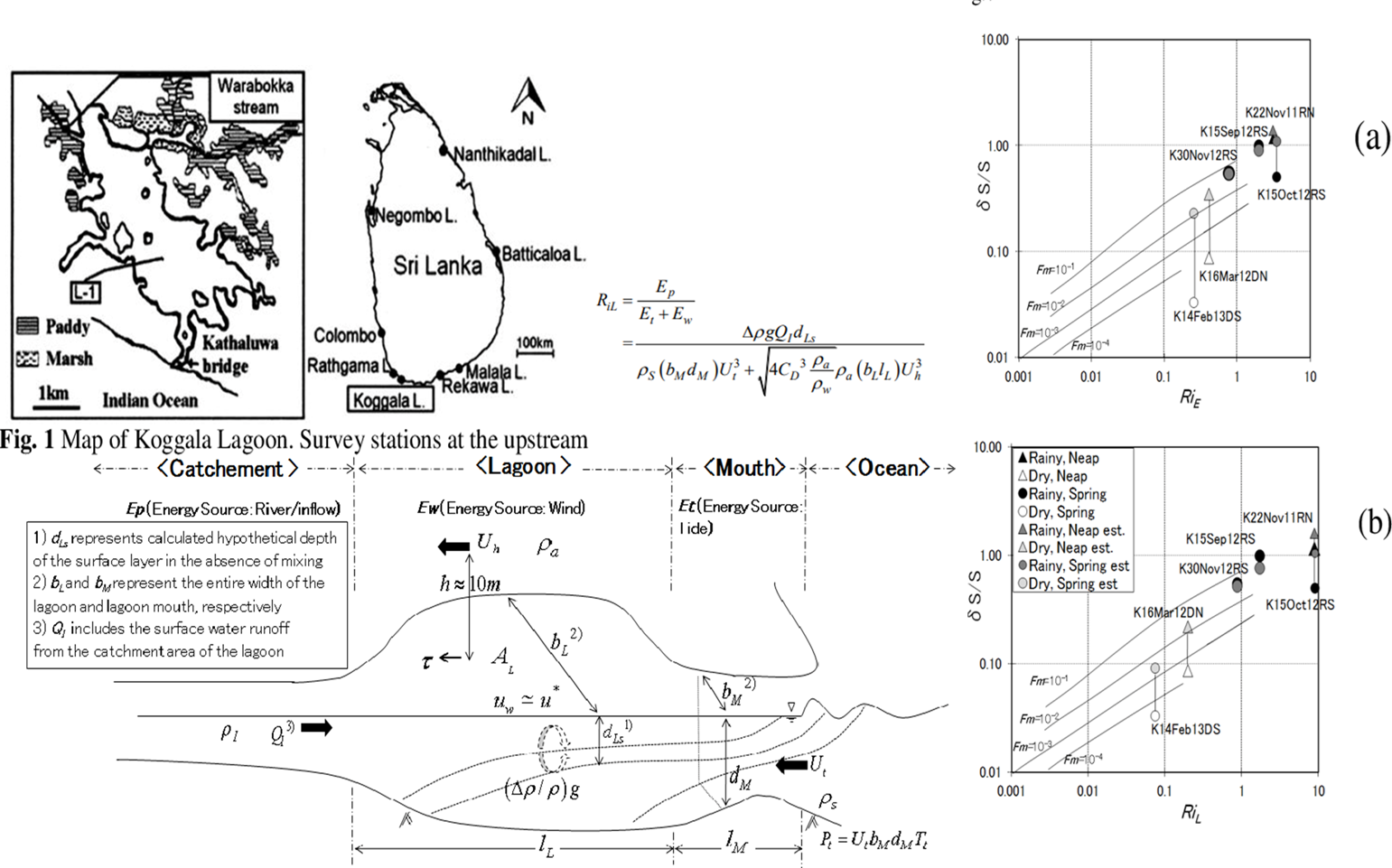A simple bulk model to estimate salinity stratification of permanently open choked open choked coastal lagoons in Sri Lanka

Designed a novel parameter, Lagoon Richardson Number (RiL), to quantify stratification in permanently open choked coastal lagoons (POCCLs), enhancing Fischer’s estuarine model by incorporating wind-induced mixing—a critical driver previously overlooked in such systems.
Key Advances
-
Model Development
- Derived RiL by integrating tidal kinetic energy, freshwater potential energy, and wind stress, enabling accurate stratification (δS/S) predictions for POCCLs.
- Achieved 22% mean improvement over Fischer’s model, with 59% better accuracy in dry seasons when wind mixing dominates (Fig. 7).
-
Field Validation
- Applied to Koggala Lagoon, Sri Lanka, using 18-month field data (2011–2013) across tidal/seasonal cycles (Table 1).
- Identified rainy-season stratification as inflow-dominated (potential energy > 7×107 J) and dry-season mixing as wind-driven (Fig. 5).
-
Geomorphic-Hydrologic Framework
- Classified Sri Lankan lagoons using dimensionless parameters (bM/lM, ACT/AL), confirming Koggala as a high-seawater-influence POCCL (Fig. 2)
-
Practical Implications
- Enhanced understanding of POCCL dynamics, aiding in management and conservation strategies.
- Facilitated accurate salinity stratification predictions, crucial for ecological health and resource management, particularly for lagoons where there is not enough data to run complex models.
Impact:
Techniques and Tools:
Publication:
- Gonaduwage, L. P.*, Furusato, E., and Priyadarshana, T. (2015), A simple bulk model to estimate salinity stratification of permanently open choked coastal lagoons in Sri Lanka, Journal of Japan Society of Civil Engineers (JSCE), Ser.B1 (Hydraulic Engineering), 71, https://doi.org/10.2208/jscejhe.71.I_25
Conference Presentations:
- Gonaduwage, L. P., Furusato, E., and Priyadarshana, T. (2015) Applicability of salinity stratification estimation by new bulk model for two choked coastal lagoons in Sri Lanka, Proceedings of the 3rd International Symposium on Advances in Civil and Environmental Engineering Practices for Sustainable Development (ACEPS).
- Gonaduwage, L. P*., Furusato, E., Tanaka, N., Priyadarshana, T. (2014) The applicability of classical bulk model for estimating salinity stratification of choked coastal lagoons in Sri Lanka, JSCE 16th International Summer Symposium, Osaka, Japan.
- Furusato, E., Gonaduwage, L. P., Tanaka, N., Amarasekara, G. P., and Priyadarshana, T. (2013), Current characteristics of salinity stratification of two coastal lagoons in southern area of Sri Lanka after different human interventions, Proceedings of International Symposium on Advances in Civil and Environmental Engineering Practices for Sustainable Development (ACEPS), 231-237.
- Chathuranga, G. A. H. S., Furusato, E., Gonaduwage, L. P., Tanaka, N., and Priyadarshana, T. (2013), Zonation pattern of Mangrove in Southern Sri Lankan Lagoon after human interventions at Lagoon mouth area, Proceedings of the special session on coastal structures, International Conference on Structural Engineering and Construction Management (ICSESM), 120-128.
- Gonaduwage, L. P*., Furusato, E., G. P. Amarasekara, T. Priyadarshana, and N. Tanaka, (2013), Current status of salinity stratification of Rekawa Lagoon, Sri Lanka, International Conference on Sri Lanka Japan Collaborative Research (SLJCR).
- G. P. Amarasekara, E. Furusato, T. Priyadarshana, L. P. Gonaduwage, N. Tanaka, (2013), Mixing status of Koggala Lagoon in spring tidal conditions, International Conference on Sri Lanka Japan Collaborative Research (SLJCR).
Collaborations:
With Dr. E. Furusato, and Dr. N. Tanaka from Saitama University, Japan, and Dr. T. Priyadarshana from University of Ruhuna, Sri Lanka.